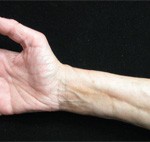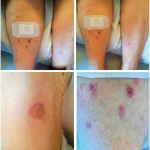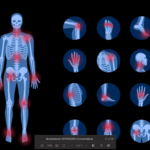On her three-month follow-up visit, she had successfully tapered prednisone to 7.5 mg daily. The pain and swelling in her hands had vanished, and although the flexion contractures had vastly improved, they were still present on examination. She had increased range of motion in her fingers and full grip strength (see Figures 2A & 2B, opposite). The swelling in her knees had resolved. The CRP had completely normalized to <1 mg/L.
At her nine-month follow-up visit, she continued to do well, with no hand pain or swelling. The contractures continued to show improvement, with no pain noted on palpation of her hand tendons. She is currently taking 2.5 mg of prednisone every other day and feels well. Her age-appropriate cancer screening has been negative.
Discussion
Palmar fasciitis and polyarthritis syndrome is a rare paraneoplastic condition characterized by rapidly progressive flexion contractures of the hands, inflammatory fasciitis, generalized hand arthritis, fibrosis and a generalized inflammatory arthritis of the joints.1 It is a non-erosive arthropathy, and laboratory tests for inflammatory markers and autoimmune antibodies are generally normal.
The etiology is thought to be due to fibroblast proliferation and connective tissue growth factors (CTGFs). The exact incidence is unknown, but since it was first described in 1982 in association with ovarian carcinoma, more than 40 cases have been reported, with the majority occurring in elderly females.2 The condition has also been associated with colon, pancreas, lung and hemolymphatic malignancies.
The rheumatic symptoms usually precede the occurrence of cancer, but can also occur simultaneously with or follow the malignancy. A handful of cases with no association with malignancy has also been described. The condition was first reported in 1982 by Medsger et al in association with ovarian carcinoma.2
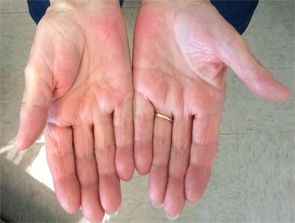
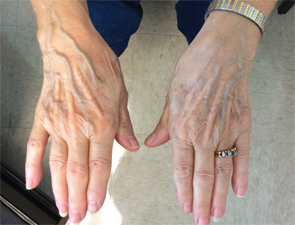
Figure 2A (left) & Figure 2B: These images show the patient’s hands following three months’ treatment with prednisone. The patient has visible improvement of the swelling and contractures and no pain on palpation.
Epidemiology
In an analysis of 41 PFPAS cases reported between 1982 and 2005, close to one-third of the cases were associated with ovarian cancer.1 Other associated malignancies include prostate, lung, breast and hematological malignancies. The rheumatic symptoms preceded the tumor detection anywhere from one to 23 months.1
The etiology of PFPAS remains unknown. Possible explanations include the activation of certain profibrotic factors from neoplastic cells or an antigen-antibody autoimmune phenomenon within malignant cells. Indeed, Medsger and colleagues had originally suggested that a fibroblast proliferative factor may be secreted by the tumor.2

